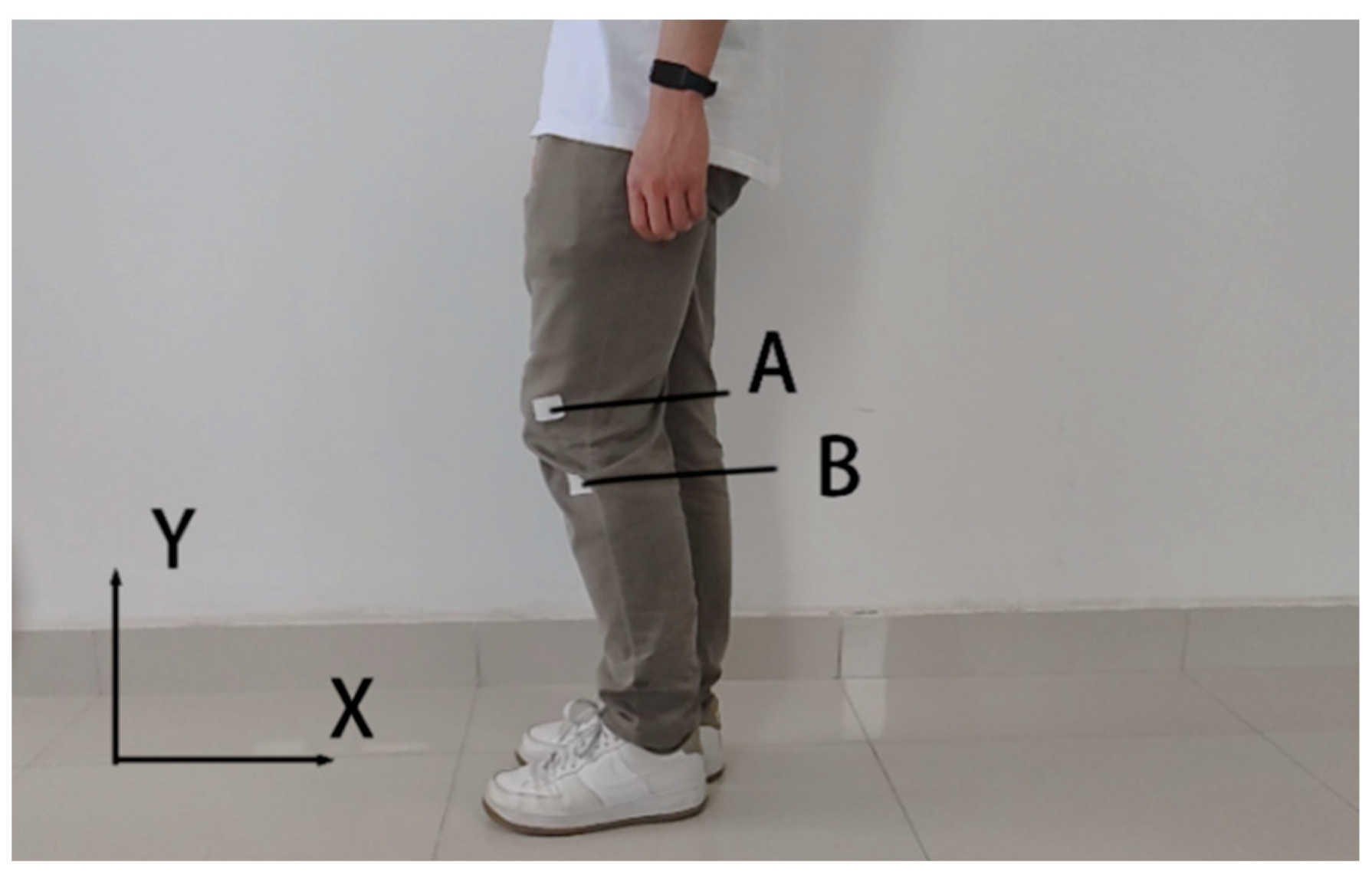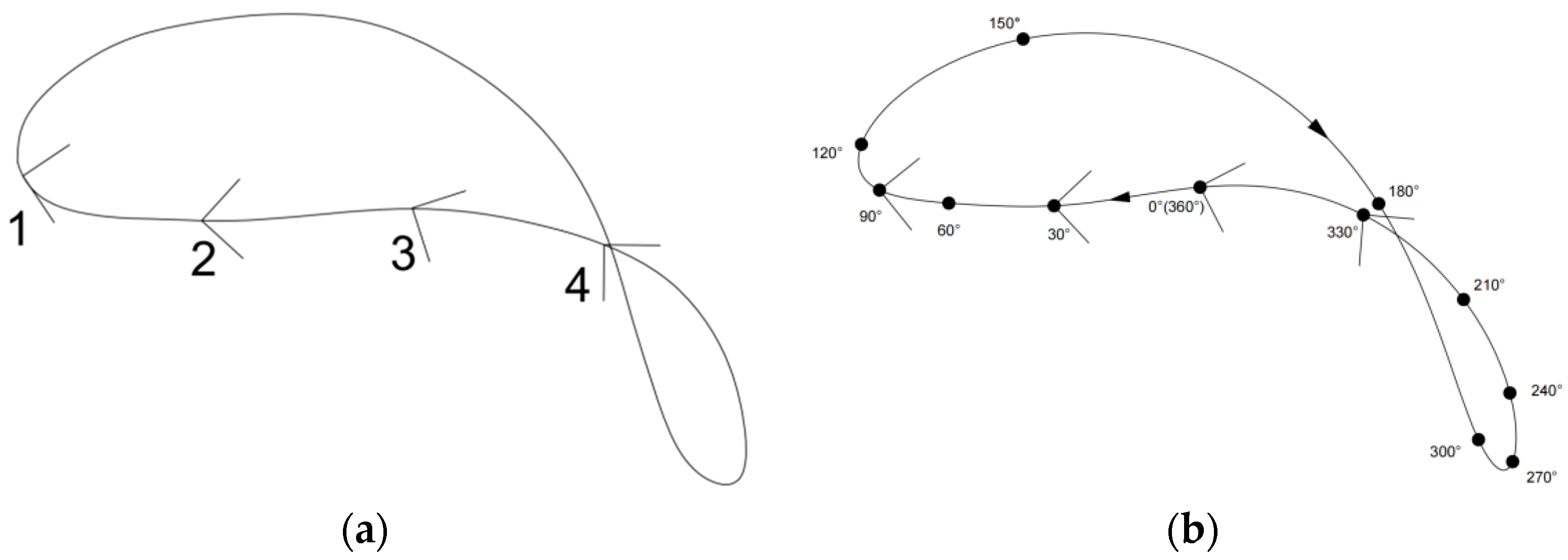Mechanism Analysis and Optimization Design of Exoskeleton Robot with Non-Circular Gear–Pentabar Mechanism
Abstract
:1. Introduction
2. Non-Circular Gear–Constrained Five-Bar Mechanism
Function Mapping of the End Trajectory of the Non-Circular Gear Mechanism
3. Establishment of the Mechanism’s Kinematics Model
4. Obtaining the Human Knee Joint Movement Position
5. Development of Optimization Design Software and Parameter Optimization
5.1. Development of Optimization Design Software
5.2. Parameter Optimization
6. Kinematic Simulation
6.1. Establishment of Virtual Prototype
6.2. Simulation
7. Conclusions
- (1)
- Aiming to address the complexity of existing rod mechanism exoskeleton knee robots and leveraging the advantages of gear mechanisms, such as stable transmission and simple structure, an exoskeleton knee robot with a non−circular gear–pentarod mechanism is proposed. The kinematic model of the non−circular gear–pentarod mechanism is established based on theoretical analysis.
- (2)
- The motion posture of the human knee joint is obtained through testing. Based on the MATLAB visualization platform, optimization design software is developed by adopting the rigid-body guide heuristic algorithm and the kinematic model of the non−circular gear−five rod mechanism. The motion trajectory of the human knee joint is set as the target trajectory, enabling the selection of an ideal set of parameters through optimization adjustment.
- (3)
- Trajectories corresponding to different rod lengths are obtained by adjusting various rod lengths. The response law of rod length parameters to the end trajectory of the actuator is derived through comparative analysis, further guiding the improved design of the exoskeleton knee robot.
- (4)
- According to the parameters obtained from adjustment and optimization, a three−dimensional model of the non−circular gear−five rod mechanism is established and imported into ADAMS for kinematic simulation. The trajectory obtained from virtual simulation, the trajectory obtained from the optimization design software, and the trajectory of the human knee joint are compared for validation. The results demonstrate that the non−circular gear−five rod mechanism complies with the design requirements and can meet the working requirements of the exoskeleton knee robot. This study did not involve physical processing or experiments in any way. The next step will be to continue processing the device and conducting tests. If problems are found during the experiments, they will be corrected in a timely manner. Additionally, a lightweight design will be pursued to reduce the weight of the device, making it more comfortable for patients to wear the equipment.
Author Contributions
Funding
Data Availability Statement
Acknowledgments
Conflicts of Interest
References
- Song, Z.B.; Ma, T.Y.; Nie, C.; Niu, Y.J. A new skeleton model and the motion rhythm analysis for human shoulder complex oriented to rehabilitation robotics. Appl. Bionics Biomech. 2018, 2018, 2719631. [Google Scholar]
- Hunt, J.; Lee, H. A new parallel actuated architecture for exoskeleton applications involving multiple degree-of-freedom biological joints. J. Mech. Robot. Trans. ASME 2018, 10, 051017. [Google Scholar] [CrossRef]
- Song, Q.Z.; Wang, X.G.; Wang, X.; Wang, Y. Development of multijoint exoskeleton-assisted robot and its key technology analysis: An overview. Acta Armamentarii 2016, 37, 172–185. (In Chinese) [Google Scholar]
- Martinez-Velilla, N.; Cadore, E.L.; Casas-herrero, A.; Idoate-Saralegui, F. Physical activity and early rehabilitation in hospitalized elderly medical patients: Systematic review of randomized clinical trials. J. Nutr. Health Aging 2016, 20, 738–751. [Google Scholar] [CrossRef] [PubMed]
- Clark, D.J. Automaticity of walking: Functional significance, mechanism, measurement and rehabilitation strategies. Front. Hum. Neurosci. 2015, 9, 246–254. [Google Scholar] [CrossRef] [PubMed]
- Gao, C.Y.; Liu, F.; Jiang, H.B. Preliminary Study on Current Research Status and Clinical Application of Lower Limb Rehabilitation Robot Mechanisms. Chin. J. Med. Instrum. 2024, 48, 30–37. [Google Scholar]
- Freivogel, S.; Schmalohr, D.; Mehrholz, J. Improved walking ability and reduced therapeutic stress with an electromechanical gait device. J. Rehabil. Med. 2009, 41, 734–739. [Google Scholar] [CrossRef] [PubMed]
- Naditz, A. Medical connectivity-new frontiers: Telehealth innovations of 2010. Telemed. E Health 2010, 6, 986–992. [Google Scholar]
- Etoundi, A.; Lock, R.; Vaidyanathan, R.; Burgess, S.C. A Bio-Inspired Condylar Knee Joint for Knee Prosthetics. Int. J. Des. Nat. Ecodynamics 2013, 8, 213–225. [Google Scholar] [CrossRef]
- D’Alessio, J.; Russell, K.; Lee, W.-T.; Sodhi, R.S. On the Application of RRSS Motion Generation and RRSS Axode Generation for the Design of a Concept Prosthetic Knee. Mech. Based Des. Struct. Mach. 2017, 45, 406–414. [Google Scholar] [CrossRef]
- Ghaemi, N.; Zohoor, H.; Ghaemi, H. Dynamic performance of different knee mechanisms with compliant joints. Sci. Iran. Trans. B Mech. Eng. 2016, 23, 1055–1063. [Google Scholar]
- Briot, S.; Goldsztejn, A. Topology optimization of industrial robots: Application to a five-bar mechanism. Mech. Mach. Theory 2017, 120, 30–56. [Google Scholar] [CrossRef]
- Sun, Y.L.; Liu, Y.Q.; Pancheri, F.; Lueth, T.C. LARG: A Lightweight Robotic Gripper With 3-D Topology Optimized Adaptive Fingers. IEEE ASME Trans. Mechatron. 2022, 27, 2026–2034. [Google Scholar] [CrossRef]
- Gao, G.Q.; Zhang, Q.; Zhang, S. Pose detection of parallel robot based on improved RANSAC algorithm. Meas. Contral. 2019, 52, 855–868. [Google Scholar] [CrossRef]
- Ji, C.; Zhang, Z.Q.; Cheng, G.G.; Kong, M.X.; Li, R.F. A Convex Optimization Method to Time-Optimal Trajectory Planning With Jerk Constraint for Industrial Robotic Manipulators. IEEE Trans. Autom. Sci. Eng. 2023, 1–18. [Google Scholar] [CrossRef]
- Zhou, M.L.; Yang, Y.C.; Wei, M.X.; Yin, D.Q. Method for generating non-circular gear with addendum modification and its application in transplanting mechanism. Int. J. Agric. Biol. Eng. 2020, 13, 68–75. [Google Scholar] [CrossRef]
- Shi, X.H.; Wang, H.B.; Sun, L.; Gao, F.; Xu, Z. Design and Dynamic Analysis of an Exoskeletal Lower Limbs Rehabilitation Robot. J. Mech. Eng. 2014, 50, 41–48. [Google Scholar] [CrossRef]
- Li, J.F.; Huang, X.Q.; Tao, C.J.; Wang, S.; Ji, R. Configuration synthesis and structure design of kneerehabilitation exoskeleton. J. Harbin Eng. Univ. 2017, 38, 625–632. [Google Scholar]
- Ma, C.S.; Yin, X.Q.; Ma, Z.D.; Mi, W.B. Axis Self-adaptive Design and Dimensional Synthesis of Knee Joint of Lower Limb Exoskeleton. Acta Armamentarii 2022, 43, 653–660. [Google Scholar]
- Yu, C.N.; Yao, K.; Zong, Y.Y.; Ye, J.; Chen, J.N. Rigid-Body Guidance Synthesis of Noncircular Gear-Five-BarMechanisms and Its Application in a Knee Joint Rehabilitation Device. Machine 2022, 10, 1110. [Google Scholar] [CrossRef]
- Li, S.; Li, Y.W.; Zhao, M.X.; Chen, Z.M.; Zhu, W.G. Synthesis and Analysis of a Lower-extremity Rehabilitation in Parallel. J. Mech. Eng. 2022, 58, 55–64. [Google Scholar]
- Lu, J.A.; Chen, Y.H. Topology optimisation and customisation of a prosthetic knee joint design. Int. J. Comput. Integr. Manuf. 2013, 26, 968–976. [Google Scholar] [CrossRef]
- Yu, H.Y.; Wang, Z.X.; Li, J.S. A study on the synthesis of rigid-body guiding mechanism method. J. Mach. Des. 2001, 12, 14–17. [Google Scholar]
- Wu, X.Y.; Zhai, S.J.; Hao, Q. Analysis and simulation of prosthetic knee joint four bar mechanism. J. Mach. Des. 2011, 28, 42–45. [Google Scholar]
- Wu, B.; Chen, Z.B.; Chen, M. Design and Simulation of a New Prosthetic Knee Joint. Mach. Des. Manuf. 2015, 6, 5–8. [Google Scholar]
- Zhou, M.L.; Wei, Z.X.; Wang, Z.L.; Sun, H.; Wang, G.B.; Yin, J.J. Design and Experimental Investigation of a Transplanting Mechanism for Super Rice Pot Seedlings. Agriculture 2023, 13, 1920. [Google Scholar] [CrossRef]
- Zhou, M.L.; Yang, J.J.; Xu, T.B.; Ying, J.J.; Wang, X.Z. Optimal design of transplanting mechanism with differential internal engagement non-circular gear trains. J. Agric. Eng. 2022, 53, 1412. [Google Scholar] [CrossRef]













Disclaimer/Publisher’s Note: The statements, opinions and data contained in all publications are solely those of the individual author(s) and contributor(s) and not of MDPI and/or the editor(s). MDPI and/or the editor(s) disclaim responsibility for any injury to people or property resulting from any ideas, methods, instructions or products referred to in the content. |
© 2024 by the authors. Licensee MDPI, Basel, Switzerland. This article is an open access article distributed under the terms and conditions of the Creative Commons Attribution (CC BY) license (https://creativecommons.org/licenses/by/4.0/).
Share and Cite
Wang, G.; Zhou, M.; Sun, H.; Wei, Z.; Dong, H.; Xu, T.; Yin, D. Mechanism Analysis and Optimization Design of Exoskeleton Robot with Non-Circular Gear–Pentabar Mechanism. Machines 2024, 12, 351. https://doi.org/10.3390/machines12050351
Wang G, Zhou M, Sun H, Wei Z, Dong H, Xu T, Yin D. Mechanism Analysis and Optimization Design of Exoskeleton Robot with Non-Circular Gear–Pentabar Mechanism. Machines. 2024; 12(5):351. https://doi.org/10.3390/machines12050351
Chicago/Turabian StyleWang, Guibin, Maile Zhou, Hao Sun, Zhaoxiang Wei, Herui Dong, Tingbo Xu, and Daqing Yin. 2024. "Mechanism Analysis and Optimization Design of Exoskeleton Robot with Non-Circular Gear–Pentabar Mechanism" Machines 12, no. 5: 351. https://doi.org/10.3390/machines12050351




